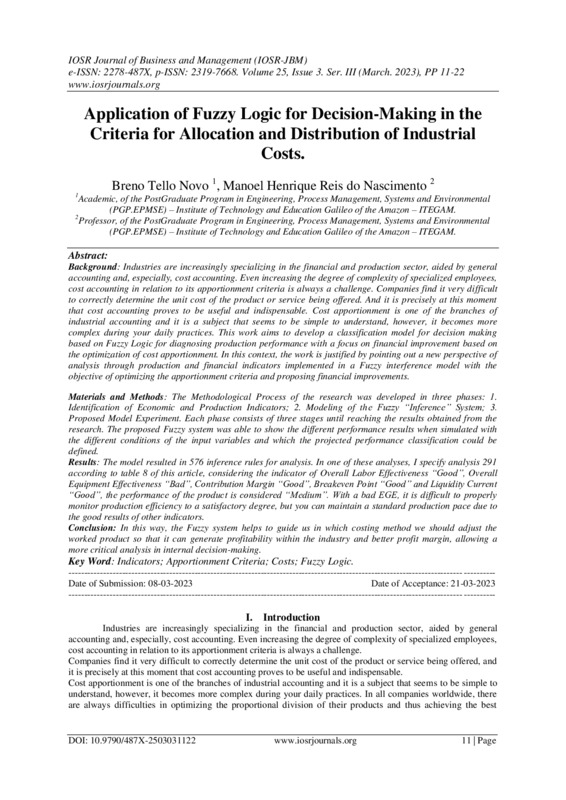-
Tipo do ITEM
-
Artigo Ciêntifico
-
Título do Artigo
-
APPLICATION OF FUZZY LOGIC FOR DECISION-MAKING IN THE CRITERIA FOR ALLOCATION AND DISTRIBUTION OF INDUSTRIAL COSTS.
-
Descrição
-
Background: Industries are increasingly specializing in the financial and production sector, aided by general accounting and, especially, cost accounting. Even increasing the degree of complexity of specialized employees, cost accounting in relation to its apportionment criteria is always a challenge. Companies find it very difficult to correctly determine the unit cost of the product or service being offered. And it is precisely at this moment that cost accounting proves to be useful and indispensable. Cost apportionment is one of the branches of industrial accounting and it is a subject that seems to be simple to understand, however, it becomes more complex during your daily practices. This work aims to develop a classification model for decision making based on Fuzzy Logic for diagnosing production performance with a focus on financial improvement based on the optimization of cost apportionment. In this context, the work is justified by pointing out a new perspective of analysis through production and financial indicators implemented in a Fuzzy interference model with the objective of optimizing the apportionment criteria and proposing financial improvements. Materials and Methods: The Methodological Process of the research was developed in three phases: 1. Identification of Economic and Production Indicators; 2. Modeling of the Fuzzy “Inference” System; 3. Proposed Model Experiment. Each phase consists of three stages until reaching the results obtained from the research. The proposed Fuzzy system was able to show the different performance results when simulated with the different conditions of the input variables and which the projected performance classification could be defined. Results: The model resulted in 576 inference rules for analysis. In one of these analyses, I specify analysis 291 according to table 8 of this article, considering the indicator of Overall Labor Effectiveness “Good”, Overall Equipment Effectiveness “Bad”, Contribution Margin “Good”, Breakeven Point “Good” and Liquidity Current “Good”, the performance of the product is considered “Medium”. With a bad EGE, it is difficult to properly monitor production efficiency to a satisfactory degree, but you can maintain a standard production pace due to
the good results of other indicators. Conclusion: In this way, the Fuzzy system helps to guide us in which costing method we should adjust the worked product so that it can generate profitability within the industry and better profit margin, allowing a more critical analysis in internal decision-making.
-
Abstract
-
Background: Industries are increasingly specializing in the financial and production sector, aided by general accounting and, especially, cost accounting. Even increasing the degree of complexity of specialized employees, cost accounting in relation to its apportionment criteria is always a challenge. Companies find it very difficult to correctly determine the unit cost of the product or service being offered. And it is precisely at this moment that cost accounting proves to be useful and indispensable. Cost apportionment is one of the branches of industrial accounting and it is a subject that seems to be simple to understand, however, it becomes more complex during your daily practices. This work aims to develop a classification model for decision making based on Fuzzy Logic for diagnosing production performance with a focus on financial improvement based on the optimization of cost apportionment. In this context, the work is justified by pointing out a new perspective of analysis through production and financial indicators implemented in a Fuzzy interference model with the objective of optimizing the apportionment criteria and proposing financial improvements. Materials and Methods: The Methodological Process of the research was developed in three phases: 1. Identification of Economic and Production Indicators; 2. Modeling of the Fuzzy “Inference” System; 3. Proposed Model Experiment. Each phase consists of three stages until reaching the results obtained from the research. The proposed Fuzzy system was able to show the different performance results when simulated with the different conditions of the input variables and which the projected performance classification could be defined. Results: The model resulted in 576 inference rules for analysis. In one of these analyses, I specify analysis 291 according to table 8 of this article, considering the indicator of Overall Labor Effectiveness “Good”, Overall Equipment Effectiveness “Bad”, Contribution Margin “Good”, Breakeven Point “Good” and Liquidity Current “Good”, the performance of the product is considered “Medium”. With a bad EGE, it is difficult to properly monitor production efficiency to a satisfactory degree, but you can maintain a standard production pace due to
the good results of other indicators. Conclusion: In this way, the Fuzzy system helps to guide us in which costing method we should adjust the worked product so that it can generate profitability within the industry and better profit margin, allowing a more critical analysis in internal decision-making.
-
Língua do arquivo
-
inglês
-
Data da Publicação
-
Ano 2021
-
Palavra-chave
-
Indicators
-
Apportionment Criteria
-
Costs
-
Fuzzy Logic
-
Autores
-
Breno Tello Novo
-
Manoel Henrique Reis do Nascimento
-
Local
-
ITEGAM - MANAUS, 2023
-
Áreas de Conhecimento
-
Otimização de Processos Industriais
-
Turma
-
TURMA 02


